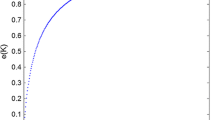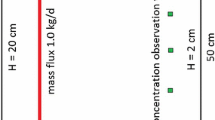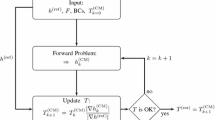Abstract
The estimation of field parameters, such as transmissivity, is an important part of groundwater modeling. This work deals with the quasilinear geostatistical inverse approach to the estimation of the transmissivity fields from hydraulic head measurements. The standard quasilinear approach is an iterative method consisting of successive linearizations. We examine a synthetic case to evaluate the basic methodology and some modifications and extensions. The first objective is to evaluate the performance of the quasilinear approach when applied to strongly heterogeneous (or “high-contrast”) transmissivity fields and, when needed, to propose improvements that allow the solution of such problems. For large-contrast cases, the standard quasilinear method often fails to converge. However, by introducing a derivative-free line search as a polishing step after each Gauss–Newton iteration, we have found that convergence can be practically assured. Another issue is that the quasilinear procedure, which uses linearization about the best estimate to evaluate estimation variances, may lead to inaccurate estimation of the variance of the estimated variable. Our numerical results suggest that this may not be a particularly serious problem, though it is hard to say whether this conclusion will apply to other cases. Nevertheless, since the quasilinear approach is an approximation, we propose a potentially more accurate but computer-intensive Markov Chain Monte Carlo (MCMC) procedure based on conditional realizations generated through the quasilinear approach and accepted or rejected according to the Metropolis–Hastings algorithm. Six transmissivity fields with increasing contrast were generated and one thousand conditional realizations were computed for each studied case. The MCMC procedure proposed in this work gives an overall more accurate picture than the quasilinear approach but at a considerably higher computational cost.




Similar content being viewed by others
Abbreviations
- m :
-
number of unknowns
- n :
-
number of observations
- p :
-
number of coefficients
- s :
-
discretized unknown function (m × 1)
- X :
-
known m × p matrix; represent the mean of the process
- \({\varvec{\beta}}\) :
-
is the process mean (p × 1)
- Q :
-
generalized prior covariance matrix of unknown function (m × m)
- z :
-
vector of observation (n × 1)
- h(s):
-
relationship between observation and unknown spatial process
- v :
-
observation error (n × 1)
- σ R :
-
measurement error
- R :
-
error covariance matrix (n × n)
- I :
-
identity matrix (n × n)
- H :
-
n × m matrix it is the derivative of h
- \({\varvec{\xi}}\) :
-
coefficients obtained by the solution of the system (3)
- \(\overset{\wedge}{\bf s}\) :
-
estimated function (m × 1)
- P yy :
-
n × n calculus matrix
- P yb :
-
n × p calculus matrix
- P bb :
-
p × p calculus matrix
- V :
-
covariance matrix of estimation (m × m)
- δ:
-
parameter of the line search
- L :
-
objective function
- G :
-
m × m calculus matrix
- s u :
-
unconditional realization (m × 1)
- s c :
-
conditional realization (m × 1)
- ρ:
-
coefficient for stability of the MCMC chain, see Eq. (12)
- α:
-
coefficient for stability of the MCMC chain, see Eq. (12)
- u :
-
unconditional realization (m × 1)
- l :
-
coefficient generated from the uniform distribution
- \(\varsigma\) :
-
probability of acceptance
- p′′(s c ):
-
posterior distribution
- \(q\left( {\bf s}_{u,i}|{\bf s}_{u,i+1}\right)\) :
-
transition probability
- x :
-
coordinates
- y :
-
coordinates
- d ij :
-
distance between the i and j point
- T :
-
transmissivity
- N :
-
Recharge rate
- ϕ:
-
head
- \({\varvec{ \theta}}\) :
-
vector of covariance function parameters
- Q 1 :
-
statistics
- Q 2 :
-
statistics
- F :
-
Fisher information matrix
- g :
-
gradient matrix of the objective function
- λ:
-
Marquardt parameter
- μ0 :
-
mean of the estimated log-transmissivity field
- ν0 :
-
variance of the estimated log-transmissivity field
- μ1 :
-
mean of the differences between the true field and the estimated one
- ν1 :
-
variance of the differences between the true field and the estimated one
- μ2 :
-
mean of the square differences between the true field and the estimated one
- ν2 :
-
variance of the square differences between the true field and the estimated one
- D 1 :
-
chi-square statistic
- D 2 :
-
mean of the square differences between the true field and the one over the variance
References
Bates BC, Campbell EP (2001) A Markov Chain Monte Carlo scheme for parameter estimation and inference in conceptual rainfall-runoff modeling. Water Resour Res 37(4):937–947
Brent RP (1973) Algorithms for minimization without derivatives. Prentice-Hall, Englewood Cliffs
Carrera J (1987) State of the art of the inverse problem applied to the flow and solute transport problems. In: Curtodio E, Gurgui A, Lobo-Ferreira JP (eds) Groundwater flow and quality modeling (NATO ASI Series). Reidel, Hingham, pp 549–585
Chen J, Hubbard S, Rubin Y, Murray C, Roden E, Majer E (2004) Geochemical characterization using geophysical data and Markov Chain Monte Carlo methods: a case study at the South Oyster bacterial transport site in Virginia. Water Resour Res 40, doi:10.1029/2003WR002883
Chib S, Greenberg E (1995) Understanding the Metropolis–Hastings algorithm. Am Stat 49(4):327–335
Dagan G (1985) Stochastic modeling of groundwater-flow by unconditional and conditional probabilities: the inverse problem. Water Resour Res 21(1):65–72
Feyen L, Ribeiro Jr PJ, Gòmez-Hernández JJ, Beven KJ, De Smedt F (2003) Bayesian methodology for stochastic capture zone delineation incorporating transmissivity measurements and hydraulic head observations. J Hydrol 271:156–170
Forsythe GE, Malcom MA, Moler CB (1976) Computer methods for mathematical computations. Prentice-Hall, New Jersey
Fritz J, Nowak W, Neuweiler I (2008) FFT-based algorithms for Kriging (Submitted to Mathematical Geology)
Ginn TR, Cushman JH (1990) Inverse methods for subsurface flow: a critical review of stochastic techniques. Stoch Hydrol Hydraul 4:1–26
Gòmez-Hernández JJ, Sahuquillo A, Capilla JE (1997) Stochastic simulation of transmissivity fields conditional to both transmissivity and piezometric data-1 theory. J Hydrol 203:162–174
Gutjahr AL, Wilson JL (1989) Co-kriging for stochastic models. Transp Porous Media 4(6):585–598
Gutjahr AL, Bulard B, Hatch S, Hughson L (1994) Joint conditional simulations and the spectral approach for flow modeling. Stoch Hydrol Hydraul 8(1):79–108
Hanna S, Yeh TCJ (1998) Estimation of co-conditional moments of transmissivity, hydraulic head, and velocity fields. Adv Water Resour 22(1):87–95
Harter T, Yeh TCJ (1996a) Stochastic analysis of solute transport in heterogeneous, variability saturated soils. Water Resour Res 32(6):1585–1595
Harter T, Yeh TCJ (1996b) Conditional stochastic analysis of solute transport in heterogeneous, variably saturated soils. Water Resour Res 32(6):1597–1609
Harvey CF, Gorelick S (1995) Mapping hydraulic conductivity: Sequential conditioning with measurements of solute arrival time, hydraulic head, and local conductivity. Water Resour Res 31(7):1615–1626
Hill MC, Tiedeman C (2007) Effective groundwater model calibration, Wiley, London
Hoeksema RJ, Kitanidis PK (1984) An application of the geostatistical approach to the inverse problem in two-dimensional groundwater modeling. Water Resour Res 20(7):1003–1020
Hoeksema RJ, Kitanidis PK (1989) Prediction of transmissivities, heads, and seepage velocities using mathematical modeling and geostatistics. Adv Water Resour 12:90–101
Kitanidis PK (1991) Orthonormal residuals in geostatistics: model criticism and parameter estimation. Math Geol 23:741–758
Kitanidis PK (1995) Quasi-linear geostatistical theory for inversing. Water Resour Res 31(10):2411–2419
Kitanidis PK (1996) On the geostatistical approach to the inverse problem. Adv Water Resour 19(6):333–342
Kitanidis PK (1997) Introduction to geostatistics, applications in hydrogeology. Cambridge University Press, New York
Kitanidis PK, Vomvoris EG (1983) A geostatistical approach to the inverse problem in groundwater modeling (steady state) and one-dimensional simulations. Water Resour Res 19(3):677–690
Li B, Yeh TCJ (1999) Cokriging estimation of the conductivity field under variably saturated flow conditions. Water Resour Res 35(12):3663–3674
Marshall L, Nott D, Sharma A (2004) A comparative study of Markov Chain Monte Carlo methods for conceptual rainfall-runoff modeling. Water Resour Res 40:W02501
Mathworks (2002), MATLAB
McLaughlin D, Townley LR (1996) A reassessment of the groundwater inverse problem. Water Resour Res 32(5):1131–1161
Michalak AM (2003) Application of Bayesian inference methods to inverse modeling for contaminant source identification. Phd Thesis, Stanford University, Stanford
Michalak AM, Kitanidis PK (2003) A method for enforcing parameter non-negativity in Bayesian inverse problems with an application to contaminant source identification. Water Resour Res 39(2) SBH 7-1, pp 7-14
Michalak AM, Kitanidis PK (2004) Application of geostatistical inverse modeling to contaminant source identification at Dover AFB, Delaware. J Hydraul Res 42 Extra issue, pp 9–18
Nowak W (2005) Geostatistical methods for the identification of flow and transport parameters in the subsurface. Phd Thesis, Stuttgart University, Stuttgart
Nowak W, Tenklenve S, Cirpka OA (2003) Efficient computation of linearized cross-covariance matrices of interdependent quantities. Math Geol 35(1):53–66
Rubin Y, Dagan G (1987a) Stochastic identification of transmissivity and effective recharge in steady groundwater flow, 1, Theory. Water Resour Res 23(7):1185–1192
Rubin Y, Dagan G (1987b) Stochastic identification of transmissivity and effective recharge in steady groundwater flow, 2, case-study. Water Resour Res 23(7):1193–1200
Rubin Y, Dagan G (1988) Stochastic analysis of boundaries effects on head spatial variability in heterogeneous aquifers, 1, constant head boundary. Water Resour Res 24(10):1689–1697
Rubin Y, Dagan G (1989) Stochastic analysis of boundaries effects on head spatial variability in heterogeneous aquifers, 2, impervious boundary. Water Resour Res 25(4):707–712
Sun NZ (1994) Inverse problems in groundwater modeling. Kluwer, Norwell
Tamminen J, Kyrölä E (2001) Bayesian solution for nonlinear and non-Gaussian inverse problems by Markov chain Monte Carlo method? J Geophys Res 106(14):377–390
Vrugt JA, Gupta HV, Bouten W, Sorooshian S (2003) A suhffled complex evolution metropolis algorithm for optimization and uncertainty assessment of hydrologic model parameters. Water Resour Res 39:8
Yeh WWG (1986) Review of parameter identification procedures in groundwater hydrology: the inverse problem. Water Resour Res 22(1): 95–108
Yeh TCJ, Zhang J (1996) A geostatistical inverse method for variably saturated flow in the vadose zone. Water Resour Res 32(9):2757–2766
Yeh TCJ, Gutjahr AL, Jin M (1995) An iterative cokriging-like technique for groundwater flow modeling. Ground Water 33:33–41
Yeh TCJ, Minghui J, Hanna S (1996) An iterative stochastic inverse method: conditional effective transmissivity and hydraulic head fields. Water Resour Res 32(1):85–92
Yeh TCJ, Liu S, Glass RJ, Baker K, Brainard JR, Alumbaugh D, LaBrecque D (2002) A geostatistically based inverse model for electrical resistivity surveys and its applications to vadose zone hydrology. Water Resour Res 38:12
Zanini A (2006) Geostatistical approach for solving inverse problems in groundwater: applications and improvements. Phd Thesis, Parma University, Parma, Italy
Zhang J, Yeh TCJ (1997) An iterative geostatistical inverse method for steady flow in the vadose zone. Water Resour Res 33:63–71
Zimmerman DA, DeMarsily G, Gotway CA, Marietta MG, Axness CL, Beauheim RL, Bras RL, Carrera J, Dagan G, Davies PB, Gallegos DP, Galli A, Gòmez-Hernández JJ, Grindrod P, Gutjahr AL, Kitanidis PK, Lavenue AM, McLaughlin D, Neuman SP, RamaRao BS, Ravenne C, Rubin Y (1998) A comparison of seven geostatistically based inverse approaches to estimate transmissivities for modeling advective transport by groundwater flow. Water Resour Res 34(6):1373–1413
Author information
Authors and Affiliations
Corresponding author
Rights and permissions
About this article
Cite this article
Zanini, A., Kitanidis, P.K. Geostatistical inversing for large-contrast transmissivity fields. Stoch Environ Res Risk Assess 23, 565–577 (2009). https://doi.org/10.1007/s00477-008-0241-7
Published:
Issue Date:
DOI: https://doi.org/10.1007/s00477-008-0241-7




